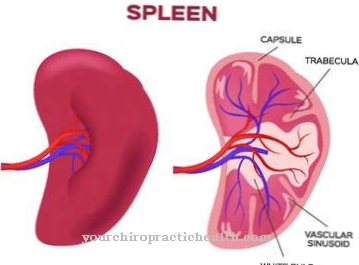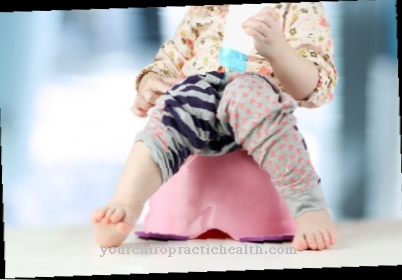The collective term Vascular malformation describes different manifestations of benign malformations of the blood and lymph vessels. The disease occurs rarely and is congenital but not inherited. All parts of the body can be affected by vascular malformations, they primarily occur on the arms and legs as well as in the head and neck area. Although the abnormalities are present at birth, they usually do not become apparent until puberty or young adulthood. Some malformations are only of cosmetic relevance, but others can also be very painful and dangerous.
What are vascular malformations?

© Henrie - stock.adobe.com
Vascular malformations - also known as vascular malformations - are malformations of the blood or lymph vessels that develop in the embryonic stage. In principle, they can occur in all parts of the body and affect the skin as well as muscles or organs. The manifestations of the anomalies are varied.
Vascular malformations with a fast blood flow (“fast flow”) are differentiated from malformations with a very slow flow (“slow flow”). The former include malformations with involvement of the arteries, the latter include venous, capillary and lymphatic vascular malformations. Veins, arteries and lymph vessels can be affected separately or in combination.At around 64 percent, venous vascular malformations are the most common form of this disease.
causes
The errors in the structure of the vascular system can be traced back to an embryonic malformation that can occur during the growth of blood vessels: The growth, known as angiogenesis, occurs through the sprouting or splitting processes of existing blood vessels.
If the process of angiogenesis is disturbed, remnants of the embryo's “supply network” remain. Fistulas or tumors can develop on the vessels of this network, which are then referred to as vascular malformations.
You can find your medication here
➔ Drugs for wound treatment and injuriesSymptoms, ailments & signs
The parts of the body affected by the vascular growths are no longer properly supplied with blood and swell. Skin changes occur and, in a further stage, open areas that no longer heal and eventually let the tissue die.
Possible symptoms are also repeated bleeding, feeling of pressure or changes in the adjacent bones and body parts, for example the jaw. Patients complain of pain in the affected limbs, secondary diseases, functional restrictions or even complete loss of function can occur.
Diagnosis & course
The course of the disease and symptoms are just as varied as the clinical picture. The clinical pictures can be differentiated according to external, superficial vascular malformations and internal, deep vascular malformations. If different types of vessels are affected at the same time, the body part in question is often tall or short.
Successful therapy therefore requires systematic diagnostics and a correct classification of the existing appearance of the malformation. After collecting the medical history (anamnesis) and a clinical examination, various imaging methods can be used.
A suitable and gentle procedure is the non-invasive ("non-penetrating") ultrasound examination, the so-called sonography. Magnetic resonance imaging (MRI) is another, non-invasive and X-ray-free procedure that provides optimal images of the soft tissue and the connection between the blood vessels and organs, nerves or muscles.
One disadvantage of MRI compared to sonography is the relatively long duration of the examination, which often makes sedation necessary for children. Computed tomography (CT) offers another option for diagnostic equipment, although this is associated with high radiation levels. The results are less good compared to MRI, but calcium deposits and bone involvement can also be shown.
Complications
As a rule, a vascular malformation can occur in any area of the body and thus lead to complaints or complications in different regions. However, most complaints are only recognized in adulthood or puberty and do not show up in childhood for the time being. Vascular malformationb does not always have to lead to complications or special complaints.
It is not uncommon for it to be a cosmetic complaint that can lead to a reduced sense of self-worth or inferiority complexes. Furthermore, the vascular malformations can also lead to short stature or directly to malformations of the inner vessels. This increases the risk of various diseases that can result from reduced blood flow. The number and frequency of bleeding is also greatly increased due to the vascular malformation.
It is not uncommon for patients to experience pain and swelling. The pain can also occur in the form of resting pain and lead to sleep problems. There are usually no complications with the treatment. Most complaints can be alleviated and combated with the help of surgical interventions. As a rule, the life expectancy of the patient is not reduced by the vascular malformations.
When should you go to the doctor?
A doctor should be consulted as soon as there is a vague feeling of illness. If you feel pressure inside your body, feel generally unwell, feel weak or tired, a doctor is needed. If you bruise repeatedly for no apparent reason, or if you notice tenderness, these signs should be examined by a doctor. In the event of pain, circulatory disorders, palpitations or disorders of the cardiovascular system, a doctor should be consulted.
If dizziness, unsteady gait, flickering eyes or nausea as well as vomiting occur, a doctor's visit is required. If the usual level of performance drops, if the need for sleep increases or if fatigue occurs quickly, a doctor is required. If the concentration or attention is disturbed, a doctor should be asked for help if the symptoms persist over a long period of time. If swelling occurs on the body or ulcers form, these changes should be examined and treated by a doctor. In the case of open wounds, sterile wound care must take place.
If this cannot be guaranteed, a doctor's visit is necessary. If the wounds become infected or do not heal within a few days, a doctor is needed. If bleeding of various kinds occurs repeatedly, a doctor must be consulted. Problems and irregularities in the bones or joints should also be examined by a doctor.
Doctors & therapists in your area
Treatment & Therapy
The treatment of vascular malformations requires close interdisciplinary cooperation between neuroradiologists, oral surgeons, ENT specialists and other specialists. The need for treatment depends on the type, location, size and a possible bleeding tendency. More harmless forms do not require invasive therapy.
While more complex vascular malformations used to require surgery, today the focus is on microinvasive radiological therapy. This is based on the so-called embolization process. A so-called angiography catheter is guided through the skin to the affected vessel via a minimal access.
The supplying vessels are either closed with small metal spirals or with a sclerosis drug such as high-percentage alcohol or ethoxysklerol foam. The procedure is usually carried out under local anesthesia; general anesthesia is usually not necessary. In most cases, repeated treatments are required because the vessels have multiple inlets and outlets.
In certain manifestations of the disease, “Laser-Induced Interstitial Thermotherapy (LITT)” can also be the method of choice. A laser fiber is inserted directly into the vascular defect in a minimally invasive manner and laser light is widely scattered in the tissue. The aim is to trigger a local inflammatory reaction and the formation of thrombi in order - after several treatments - to sclerosing the tissue.
Overall, the treatment of vascular malformations is safe and relatively few complications. When venous malformations are sclerosed, swelling and pain often occur after the treatment.
Outlook & forecast
The prognosis of the vascular malformation is to be assessed according to the individual circumstances of the patient. For some of those affected, there are no significant impairments or malfunctions in their entire life. Although the disease is present and has been diagnosed without errors, they report that there are no symptoms. In a stronger form of the vascular malformation there are cosmetic blemishes. In many cases, these can be changed in a surgical procedure, but are only of cosmetic relevance.
If the malformations are more extensive, there is the possibility of a life-threatening course of the disease in severe cases. In order to avoid this, surgeons carry out corrections in a surgical procedure. If the operation proceeds without complications or secondary diseases, the patient can be discharged after a short time as symptom-free. As a safeguard, check-ups are recommended, especially in the initial phase.
If there are no irregularities, the patient is normally cured for life. However, this prognosis can only be made after the child's growth and development process has been completed. During this time there is a possibility of changes or the development of new malformations, which must also be corrected.
Patients with vascular malformations should monitor their blood circulation throughout their lifespan to improve their health. If you notice circulatory disorders, you need to see a doctor as soon as possible so that treatment can be started immediately.
You can find your medication here
➔ Drugs for wound treatment and injuriesprevention
Since vascular malformations are usually congenital, prevention is not possible. However, early detection and treatment improves the success of the therapy. Accompanying physical measures such as compression and physiotherapy can help prevent functional restrictions or improve existing restrictions.
Exercise therapy can also be useful for those affected. Patients should also receive psychological support. Since the disease changes in the course of life, spontaneous healing can be ruled out, and malformations can also increase, regular checks should be carried out.
Growth spurts of vascular malformations can be caused by hormones during puberty or pregnancy as well as by injuries or surgical measures. The aim of the accompanying measures is to be able to use the affected organ as unrestrictedly as possible.
Aftercare
In most cases of vascular malformations, follow-up care options are not possible or necessary. Those affected are primarily dependent on medical treatment of the symptoms, although not all vascular malformations have to be treated. However, a doctor should always be consulted at the first signs in order to identify and remove dangerous vascular malformations early on.
This is the only way to prevent further complications or the development of tumors. In most cases, the malformations are removed by surgery. There are no particular complications. After such an operation, those affected need to take care of their bodies and rest.
Stressful activities or sporting activities should be avoided. Above all, the affected areas should be particularly protected. Even after the vascular malformation has been successfully removed, regular examinations of the entire body are useful in order to identify and treat a recurrence in good time.
In the event of pain or swelling, visits to a doctor are also necessary. If the vascular malformations are removed early, the life expectancy of the person affected is usually not reduced. Since the complaint can also have a negative effect on the aesthetics of the person concerned, help and support from your own family and friends is very useful.
You can do that yourself
As a rule, there are no special options for self-help or self-treatment available to those affected with a vascular malformation. The patients are therefore always dependent on treatment by a doctor in their lives in order to avoid further complications and complaints.
In the event of severe muscle cramps, an emergency doctor can be called directly or the hospital can be visited. Since many of those affected also suffer from paralysis or significantly reduced sensitivity due to the vascular malformation, they are often dependent on the help of other people in their everyday lives. Above all, the help of family and friends is very efficient.
Visual disturbances can usually be compensated for by using visual aids. In the case of balance disorders, walking aids can be useful to avoid accidents and other injuries.
Communication with other patients with vascular malformations often has a positive effect on psychological complaints and can contribute to an exchange of information that can be helpful in the everyday life of the person concerned.



.jpg)









.jpg)

.jpg)
.jpg)











.jpg)